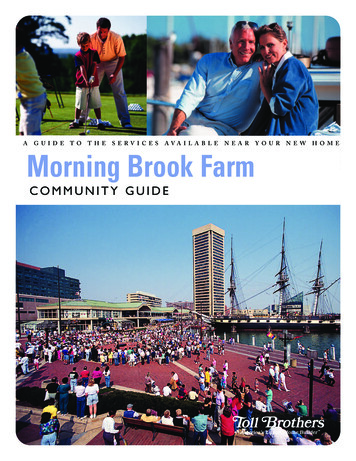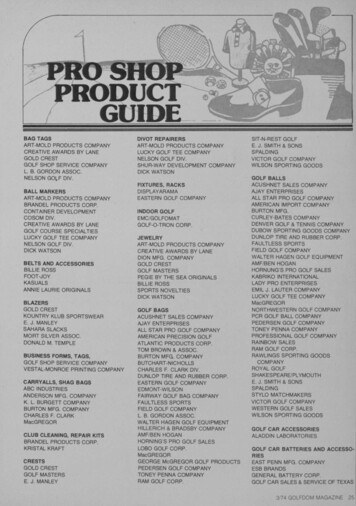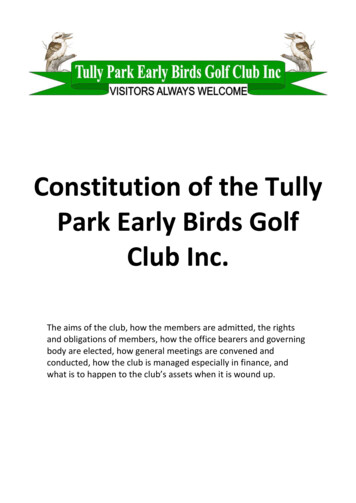
Transcription
2016A GovernanceGuide ForGolf Clubs
2
HOW TO STRUCTUREAND RUN YOURCLUB EFFECTIVELY:CLUB GOVERNANCESTARTER GUIDEForwardDate Last Reviewed: September 2016 Version: 1Our Vision: Golf clubs havestrong governance andunderstand how to structure andgovern themselves effectively todeliver their strategic objectives.Our Mission: Provide golf clubswith the necessary advice andsupport on governance issuesto enable them to realisetheir potential.‘How can a golf club improveits governance?’ This is aquestion frequently put by golfclubs to the various nationalorganisations and membershipbodies who support and workwith them. As there are so manyplaces to turn to for governanceadvice and legal support, wehave come together to provideyou with a consistent messageon ‘what a good golf club lookslike’ and a consistent view onhow to structure yourselves anddevelop a plan for the future.This starter guide identifiessome areas to consider in termsof structure and planning,which will then enable you tobe more effective and improvehow you run your club. It isdesigned to be a foundationblock for you to build from withour assistance. We will work toproduce updates and furthersupporting documentationsuch as templates, casestudies and toolkits.We EncourageYou To: Commit to and workthrough the principlesand advice set out inthe guidance. Seek one-to-onesupport from yourmembership bodies. Provide feedbackon what additionalgovernance elementsyou would welcomeassistance with.We hope this document will have a significant and lasting impact onhow you run your golf club and will provide you with the knowledge,insight and tools to help you improve your governance to becomemore effective as organisations3
ContentsHow should youuse this guide?The aim of this guide is to provide you with astarting point to develop the most appropriatestructure and organisation for you to successfullyrun your golf club.By benchmarking your club against the goodpractice contained here, you will be able toprioritise your areas of improvement and takesteps methodically to improve your governance.This is unlikely to require legal or accountancyinput, however some specific changes you maywish to make could require legal and financialadvice, and therefore this guide should besupplemented by one-to-one support and expertadvice when necessary.This Guide Is Not: All you will ever need A replacement for one-to-one support Specific legal or accountancy advice onyour particular situationHow is this guide structured?This guide is divided into the following sections:Glossary: This provides a definition of some of the key terms used throughout this guide.6Section One: An introduction to GovernanceThis section provides a basic introduction to governance and some core governance principlesto be aware of in a general context.8Section Two: Organisational StructureThis section provides information on the different legal structures that a golf clubcan adopt in order to create a club management structure.12Section Three: Management CommitteeThis section provides more detailed information on the role of the Management Committee,including terms of reference, skills-based selection, ways of working, and individual role profilesfor members of the Management Committee.154
Section Four: Strategic PlanningThis section provides an over-view of the strategic planning process and provides informationon why it is important to have a strategic plan; what the benefits are of having a strategic planand how to go about creating a meaningful one.17Section Five: Further Resources and SupportThis section provides information on other governance resources that you may be starting toconsider and where to find them.21Section Six: Contact Details for SupportThis section provides the contact details to obtain further support and find out how to continueimproving your governance beyond using this document.23Section Seven: ToolsThis section provides some tools to help you further understand and implement some of therecommendations and practices outlined in this guide. The following tools are provided in theguide (although others can also be requested directly from the partner organisations whichproduced this guide):24 TOOL 1: An information sheet on Incorporated versus Unincorporated TOOL 2: An information sheet on the options for the Management of a Golf Club TOOL 3: Template Terms of Reference for a Management Committee TOOL 4: Sample Role Descriptions: Chairperson General Manager Company Secretary Captain Treasurer President TOOL 5: Good Governance Case Study: Deeside Golf Club5
GlossaryBoard Directors/ManagementCommittee/Trustees/Executive CommitteeThis can be called a number of different things but when this guiderefers to a management committee it means the strategic decisionmaking non-executive function at the top of the golf club.Core ValuesAn organisation’s core values are the guiding principles which applyacross the organisation and underpin how its work is carried out. Anorganisation’s values are its basic beliefs about what really matters,and they should guide how things are done.General ManagerDe facto CEO who manages the day-to-day operations.GovernancePutting in place structures, policies, procedures and processesto meet legal requirements and ensure your organisation is runefficiently and effectively for the long term.Mission StatementThe mission statement should clearly define the purpose ofan organisation. It is a short, formal statement about what theorganisation aims to do and why it is trying to do it. It is the reasonthe group or organisation exists and helps to keep everyone involvedin the organisation focused.OperationThis is the detail and the ‘doing’ part of any plan. Often a strategicplan will be underpinned by an operational/business/act/functionalplan that will go into the detail of what is needed and what tasks arebeing completed to meet the strategic objectives.Operational CommitteesCommittees established by the General Manager to assist him/her torun the operational aspects of the club e.g. clubhouse, bar, catering,greens, admin etc.PESTLEPESTLE analysis is used as a tool by organisations to track theenvironment they are operating in. The acronym is as follows: P forPolitical, E for Economic, S for Social, T for Technological, L for Legaland E for Environmental. It helps an organisation to check and keeptrack of the wider environmental influences while creating an idea ora plan.6
StructureStructure also relates to how an organisation is legally constituted.This guide outlines the benefits and responsibilities an organisationmay have as a result of their legal structure.StrategyThis is a long-term, master plan for success. It is high level and doesnot focus on the detail, but instead focuses on the key priorities andthemes for achieving those objectives and priorities.Sub-committeesCommittees established by the Management Committee to assistin strategic issues. Committees exist to make strategy and policydecisions to ensure the club can be run effectively and sustainably.SWOTSWOT is a useful tool which helps organisations understand theirunique offering and may help them assess the potential success ofan idea or a project. It can also provide a useful starting point fordeveloping a strategy by forcing an organisation to identify how it isdistinct from other similar organisations.The acronym is as follows: S for Strengths, W for Weaknesses,O for Opportunities and T for Threats. It is designed to help anorganisation uncover opportunities that can be exploited, atthe same time as understand weaknesses and manage them toeliminate threats. Strengths and weaknesses are often internal toan organisation, while opportunities and threats generally relate toexternal factors.VisionA vision is the long-term change an organisation would like to see ifits work is successful. A vision should motivate and enable individualsto see how their effort contributes to an overall inspirational purpose.It is a clear and inspirational hope for the future.Working GroupsCommittees established by the Management Committee to focuson short term projects and deliver against time sensitive one-offinitiatives. After the project is complete, the working group will notcontinue to meet or exist.7
Section One:An introduction to GovernanceGovernance over the last decade has become a focus point for organisations in both thecommercial and not for profit sectors. Sports organisations, whether they are nationalgoverning bodies, regional associations or clubs are also being encouraged by funders,stakeholders and members to address their governance, ensure they are fit for purposeand put measures in place to adhere to minimum governance standards.So what do we mean whenwe speak about governance?Governance is how the systems, processes,behaviours and people in an organisationcome together to make things work.In reality this means there aretwo parts of governance.The first part focuses on putting in placepolicies, procedures, documents and processesto enable an organisation to run effectively.The second part focuses on how an organisationuses those policies and procedures, combinedwith the behaviours and culture of theorganisation, as it goes about its daily business.An organisation trying to put goodgovernance in place is a two-step process1. Implement policies and procedures2. Ensuring a positive and dynamicculture is in place for effective decisionmaking and appropriate use ofthose policies and proceduresGovernance can therefore be defined as: Putting inplace policies, procedures and processes to meetlegal requirements, at the same time as takingresponsibility for setting your own standards,driving your own improvement, and constantlydeveloping the culture of your organisation.Governance is not only about meeting legalrequirements, but also about changing behavioursand going above and beyond what is requiredto ensure your organisation runs well and can beattractive to funders, stakeholders and members.8Why should organisationsbe trying to improve theirgovernance?The idea of ‘fit for purpose’ organisations withstrong governance is appealing ontwo levels:1. It means that an organisation meetsminimum requirements and iscompliant with legal obligations2. It follows that a well governed organisationwill be sustainable for the futureMany funders or commercial sponsors will requireorganisations to meet minimum governancestandards and legal requirements to ensuretheir investment is protected and they areproviding money to well-run organisations.Beyond this, we now live in a world wheremembers are consumers. They have highexpectations of how organisations should berun and so ensuring an organisation is runeffectively will help keep members engaged.It is also important that an organisation issustainable beyond the life-time of its currentadministrators so that it can continue tobe a strong organisation in the future.Ensuring good governance is in place willhelp to make organisations work by makingthe best use of people’s skills, but notbeing so reliant on them that without oneperson the organisation cannot function.
Good governance can helpan organisation achieve: Funding from external organisations Better management of risks andchallenges as they arise More members as a result of deliveringa better service and being morein tune with member needs Better performance on the fairways as a resultof having the right structures in place to attracttalented players and allow them to flourish Sustainability for the future as a resultof being more attractive to funders andmembers, and having in place an appropriatestructure and proper financial systems tomanage investment and money across aclub rather than relying entirely on peopleWhy is governancerelevant for golf clubs?A golf club is run by an elected ManagementCommittee which has the responsibility tomake decisions that will benefit the membersand ensure a sustainable future for the club.The elected Management Committee has towork and interact well with different peoplesuch as paid staff, volunteers and members.Having in place good governance in terms ofprocesses, systems and practices will help toensure accountability of the elected ManagementCommittee and transparency of its actions tothe membership. It will also ensure that whilstoperating against the backdrop of a strugglingeconomy, processes are in place for maintainingeffective relationships and decision making to buildsustainability for the golf club going forwards.In many ways, golf clubs that work on theirgovernance will be ahead of the curveand put themselves in a strong position toface the ever-changing challenges that willemerge in the world we live in. These includeshifts in membership, changes to localgovernment policies, statutory obligationsand evolving communications platforms.Principles ofgood governanceIn the future we will be working across golforganisations to develop our own set ofprinciples of good governance for golf.These will build on the existing work in thesport sector by taking the principles set outfor all sports organisations and making themspecific and relevant for golf organisations.It is useful for golf clubs to be awareof the principles of good governanceadhered to across the sports sector.These are set out in the Sport & RecreationalAlliance Voluntary Code of GoodGovernance which is available ntary-code-of-good-governanceThe Voluntary Code was designed toenable sport and recreation organisationsto aspire to and maintain good governance.It is a tool to help Boards perform their roleby outlining seven simple principles.9
The principles are listed below with a short explanation:1. Integrity:Acting as guardians of the sport, recreation, activity or area.Management Committee members to uphold the highest standardsof integrity in the Board room but also throughout the environmentof the sport. This could include developing the following: Safeguarding Policy Equality, Diversity and Inclusion Policy Anti-Doping Policy Gifts and Hospitality Policy Conflicts of Interest Policy Discipline and Grievances Policy Whistleblowing Policy2. Defining and evaluatingthe role of the Board:Management Committee members need to have clear roledescriptions and an understanding of their individual and collectiveroles. They should also evaluate their collective and individualcontributions and performance for the organisation. This couldinclude developing the following: Clear Role Descriptions Codes of Conduct Skills Matrixes Committee Evaluation3. Delivery of vision,mission and purpose:The organisation should have a clear high level strategy and visionprovided by the Management Committee. The ManagementCommittee should not be involved in operational delivery. This couldinclude developing the following: Strategic Plan Operational Plan Budget and Forecast10
4. Objectivity:Balanced, inclusive and skilled Board. The ManagementCommittee should be made up of the right balance ofskills and expertise to meet the needs of the organisation.This includes the need for independent expertise andfor representation of the diversity of the sport.This could include: Independent Committee Member role descriptions Rules to allow for open recruitment and diversity in roles5. Standards, systemsand controls:The organisation needs to have standard operating proceduresand ensure there are appropriate and effective controls over theorganisation. This could include developing the following: Risk Management Policy Schedules of Delegated Authority Financial Policies and Procedures6. Accountabilityand transparency:Being open and accountable to members ensures an organisationcan stand up to scrutiny when reasonably questioned.This could include developing the following: Communication Policy Strategy for managing and communicating minutes ofmeetings appropriately7. Understanding andengaging with thesporting landscape:Being aware of the international and domestic sporting world toensure all decisions are taken in an informed and measured way,having looked externally as well as internally for the best solution.11
Section Two:Organisational StructureThe typical structure for any golf club will depend on the size of its membershipand the income it generates.Larger clubs may have a General Managerto manage the day-to-day operations of theclub. The General Manager is the de factoCEO and is responsible for the recruitmentand management of the employees, under thedirection of the Management Committee.Smaller clubs will rely on their volunteerofficers within the Management Committeeto manage the day-to-day activities ofthe club. The types of management andtheir benefits are set out in Tool 2.A Management Committee’s role is to governthe organisation on behalf of its members.The committee will be the Board of Directorsin an incorporated club or act as a Board ofDirectors in the case of unincorporated clubs.At a club’s AGM, the voting club membersappoint the Management Committee. Ifthe club is incorporated these individualsare the Directors of the Company and sowill be elected by the membership.Beyond the appointments of theManagement Committee, a club whetherit is incorporated or not, will likely want toappoint individuals into either Sub-committeesof the Management Committee, workinggroups or into operational committees.The three different types of committees/groups are outlined below:Sub-committees:May be established by the ManagementCommittee to oversee elements of thestrategy and assist in strategic issues. Theywill have an oversight function and will not beresponsible for doing the work of a club.12They are sub-groups of the main ManagementCommittee. Membership of the Subcommittees will include members of theManagement Committee but independentmembers may also be appointed intothe Sub-committees by the ManagementCommittee, to assist and offer expertise.Sub-committees will report and be accountableto the Management Committee.Working Groups:May be established for short term projects bythe Management Committee. These are similarto Sub-committees to the extent that theManagement Committee can determine themembership of the working group and the groupis accountable to the Management Committee.However, unlike a Sub-committee, a workinggroup is established to deliver against a specificproject or need for the club, for a specifiedperiod of time. After the project is complete,the working group will not continue to meet orexist. Working groups can be helpful becausethey enable clubs to engage people withrelevant skills for specific projects, withouthaving lots of long standing Sub-committeeswithout a defined ongoing role or input.Operational Committees:May be established by the General Manager toassist them in running the operational aspectsof the club. These committees will do the workof the club and implement the strategy.Membership of the operational committees caninclude Management Committee members, butit is likely these committees will be made up ofother people who are appointed to specific rolesby the General Manager to deliver specific jobs.
If the individuals appointed to the operationalcommittees are Management Committeemembers then they must be aware that theyhave a dual function for the club. Their roleon an operational committee is to implementand do the work, as opposed to their roleon the Management Committee, which is toover-see the work. Operational committeeswill report to the General Manager.What is the legalstructure of your club?Here is a list of thedifferent legal structures: Incorporated (companies Ltd by Guarantee) Unincorporated Registered Society Registered CharityCommittee members can apply the assetsof the club to discharge any liabilityarising from those proceedings.If the assets of the club are insufficientto fully discharge the liability then, inthe case of unincorporated bodies,the Management Committee could bepersonally liable for any shortfall.This risk of having to pay liabilities out of theirown assets seems an unfair burden on volunteers.Whilst the club constitution should provide theManagement Committee with an indemnityfrom the members and appropriate insuranceshould be put in place, there are likely to beincidents potentially not covered by insuranceand clubs should consider incorporationto gain the benefit of limited liability.The benefits and disadvantages of incorporatedand unincorporated bodies are set out in Tool 1.Optimum Structure Incorporated CharityTop Tip: Clubs are highly advised toincorporate to get the benefits of limitedliability and this is particularly important wherethey hold land and employ staff.Legal LiabilityMany clubs are choosing to incorporateas a legal corporation e.g. company.Incorporating an organisation as a companylimited by guarantee is attractive becauseit limits the liability faced by directors(officers) in the case of insolvency (not incases of negligence or recklessness).The optimum structure brings together allmembers of the club working towards a commongoal i.e. the success of the club. It is imperativethat the long-term plan is communicated andunderstood by all, with the structures, policies,and procedures in place to ensure the goals withinthe plan are attained. Such a structure shouldrecognise the various elements of a club andfacilitate those responsible for specific areas tofocus on specific roles.The focus of the Management Committee is to setthe strategic direction of the club and to delegateday-to-day responsibility for operational deliveryto the General Manager.If the club is unincorporated, should an eventoccur where the club is being sued, theManagement Committee members tend to be thenamed defendants as well as potentially trustees,as the club does not exist as a legal entity.13
Fig 1:MembersManagement Committee 1 Chair plus 5 - 9 members Senior Staff (non-voting)General ManagerStaff Clubhouse, Bar andCateringClub (Operational)Committees Greens Admin Club ProfessionalRole of Senior Staff inManagement CommitteemeetingsIt is also important to involve the senior staffin management committee meetings, albeitin a non-voting capacity, as their expertisecan be called upon to inform decisionmaking. It is also likely to generate a greatersense of partnership and co-operation.See Tool 5 for a Case Study which showsthe benefits of involving senior staff inManagement Committee meetings.14Sub-Committees & WorkingGroups
Section Three:Management CommitteeWhat is the role of aManagement Committee?A club’s success is largely down to the workof its Management Committee and Subcommittees. Sub-committees exist to makestrategic and policy decisions to ensure theclub can be run effectively and sustainably.To help achieve this, the Management Committeeand all Sub-committees should have: Clear terms of reference to define their purpose Skills-based role descriptors to ensureindividuals with relevant expertisecan be deployed to key areas ofdecision-making structures Policies and procedures to support asmooth and transparent operationCommittee and transparent communicationbetween each Sub-committeeThe role of the Management Committee is broad,but some key areas of responsibility are set out inthe Terms of Reference in Tool 3.Top Tip: The majority of the terms of referenceshould come from the club constitution. Wheregaps are identified to ensure the effectivemanagement of the golf club, amendmentsto the club constitution may be required.Role within theManagement CommitteeRoles descriptors should be used to: Appoint a skills-based Management Committee Provide clarity to members on their functionsSub-committees may be created by theManagement Committee to assist themin carrying out their duties, so they areextensions of the committee and report to it.Top Tip: Sub-committees should not haveauthority over management of staff and shouldbe appointed with clear terms of referenceand to deliver against clear objectives. Outline the expectations of the rolesThe Management Committee maycontain some or all of these roles:1. Chairperson2. Secretary3. General ManagerTerms of reference4. Treasurer5. Directors or TrusteesTo create an effective structure,the Management Committee andeach Sub-committee must haveclear terms of reference which: Clarify the committee’s purpose and activities6. President – if Presidents are ambassadors, theymay not necessarily be full voting members7. Additional rolesappointed volunteers, Sub-committee Chairs Set out the membership of the committeeand how members are appointedSample role descriptors for ManagementCommittee representatives are set out in Tool 4. Define the limits of authorityon spend and activitiesIn the past many clubs have had the ClubCaptain or both the Men’s Captain and Ladies’Captain on the Management Committee aswell as the Chair of House, Chair of Greensand the Junior Organiser or Captain. Outline the roles and responsibilities Include reporting frameworks that ensurethere is sound oversight by the Management15
Thinking Point: Clubs should really determinewhether the functions of these positions shouldbe involved in the strategic and policy decisionsto ensure the club can be run effectively andsustainably.Their roles may be better performed in Subcommittees of the Management Committeelooking at those specific important areas thatmight not be appropriate for the Board to look atin detail.Suitable Sub-committees where these roles andpositions could sit may include, member liaison;handicap and competitions; or communications.Conversely these roles may sit more appropriatelyin operational committees reporting to the GeneralManager where they are delivering and doing thework of the club. Integrity and confidentiality - keep inconfidence the issues, discussions andactions of the Management Committee Working knowledge of golf and ofgolf governing bodies, includingpolicies and procedures Understanding of collective responsibilityWays of WorkingAn effective management committee is onethat adopts the following good practice: Has an elected Chairperson Implements a robust induction programmeand offers educational opportunitiesSkills-Based Selection Works from a well-documentedstrategic plan and set of financialsIn order to effectively fulfil the dutiesand responsibilities of the ManagementCommittee, representatives must be soughtout and selected based on their skill set. Implements a clear set of corepolicies and proceduresDetailed role descriptors and a nominationscommittee that adequately reflects theexisting and potential membership willenable the best opportunity to drawtalent from all sections of the club. Schedules a minimum of five managementcommittee meetings a year Has an audit and risk committee, including atleast one external and independent accountant Undertakes an annual committee performanceevaluation involving external inputIn addition, each representative, regardless ofrole, requires the following key competencies: Manages a staggered rotation system witha minimum/maximum term of office Listening skills – in order to understand eachother’s perspectives and aid healthy debate Embraces a diverse nominationscommittee to identify and attractrepresentatives based on skill Communication skills – oral and written,enabling clear, concise and constructivecommunication, especially in meetings Analytical skills – the ability to preparefor meetings by understanding the keyissues and asking constructive questions Demonstration of club values – lead byexample with the values and leadershipbehaviours visible to staff, members and visitors16
Section Four:Strategic PlanningWhy is it important tohave strategic plan?Elected club leaders who change on a regularbasis may result in inconsistency in the leadershipof a golf club. This may in turn, dependingon the election term for individuals, resultin a transient management committee.Having a strategic plan in place can help tosafeguard the priorities of a club by providinga consistent common objective that allelected Management Committee membersneed to work continuously towards.This new consistency will help the club focusits resources in the areas identified by themembership as key priorities for the club, andwill get individuals acting on their own viewsrather than on agreed common core objectives.Having a strategic plan will help set out aplan for achieving success. The future successof the club will not be judged by the size ofthe document produced, but will be judgedby the results that the plan generates.How to create a meaningfulstrategic plan?The process of creating a strategic plan is gearedup to establish answers to three core questions:1. Where are we now?2. Where are we going?A wider perspective of a club’s position in thelocal marketplace can be taken by evaluatingthe relative strengths and price comparisonswith clubs in a 20-mile radius, and nationalgoverning bodies have tools that can assistclubs understand their potential customers intheir locality. You should contact your nationalorganisation for access to these tools.Other business-like tools such as SWOT or PESTLEcan be used to help frame discussions with as widea group of stakeholders as possible. (See glossaryfor information about SWOT and PESTLE tools).The start of a strategic planning process isan ideal time to engage the full membershipin a survey. Further analysis can be hugelymeaningful within a members’ forum, to whichall members are invited to offer their viewson the strengths and weaknesses of the clubright now. Gaining such a mandate from thestakeholders/members is crucial in remainingloyal to the established direction of the club.From each of the steps involved in thisanalysis will emerge a clear picture of whatmakes a club special, and this can be referredto in the plan as the core purpose, or
Board Directors/Management Committee/Trustees/ Executive Committee This can be called a number of different things but when this guide refers to a management committee it means the strategic decision-making non-executive function at the top of the golf club. Core Values An organisation's core values are the guiding principles which apply











